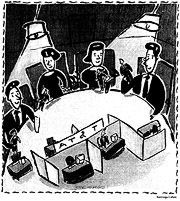
Where The Cadre Sets The Pattern
The New York Times - June 30, 1991 - By Claudia H. DeutschAt AT&T Credit, organizational snarls were tackled by the rank and file.
The American Telephone and Telegraph Corporation's financing arm, AT&T Credit, is in turmoil. Since October, the unit, with S2.5 billion in assets and 300,000 customer accounts, has been rejiggering job titles, responsibilities and bonus plans. In May, it moved here from nearby Morristown. Many of its 620 employees are lining up for courses in coping with change.
Yet the staff is energetic rather than panicked. One reason: Every aspect of the new structure, from the description of the president's job to the decor, was designed by the workers.
"These people rebuilt this company from the ground up and that gives them a sense of ownership," said Irving H. Rothman, the credit subsidiary's president.
Added James D. McGrane, who headed the team that designed the new organizational structure: "We've gone from a system where problems got passed from employee to employee to one where problems get solved."
AT&T Credit's route to this system proves that, despite much academic insistence to the contrary, the Japanese process of bottom-up consensus management can apparently work in at least one American corporate culture.
Back in 1985, when AT&T Credit was formed, management assumed that large companies would buy big systems requiring complicated financing, while small companies would buy smaller systems and make do with standard forms of financing.
So it gave one group of employees start-to-finish reponsibility for national accounts and big transactions. Teams of workers on a white-collar assembly line processed purchases made by small companies.
The setup satisfied no one. Small customers clamored for more flexible financing and personal service. Large companies wanted a speedier turnaround. Employees shuffJed papers between the two systems. Inevitably, documents got lost, infuriating the AT&T equipment salespeople who served as buffer between the credit arm and the customer. "The system wasn't responsive to anyone's needs," recalled Maria Dominguez-Zuk, a credit manager who was a design team member.
By 1989, morale was at a nadir. "The whole place suffered from diminished energy," Mr. Rothman recalled. Management's answer: Pick 10 employees, train them in team-building and organizational design and tell them to spend 50 percent of their time designing a merged, re-energized system.
The team proceeded slowly and methodically. First, it visited customers and equipment salesmen to discuss their needs. Then it interviewed about 90 AT&T Credit employees, and sent questionnaires to the rest. It also held monthly coffee klatches with employees, and fielded questions and comments relayed to team members via voice mail.
"We wanted to be a filter for everyone's needs," said Arlene Sena, a team member and a manager in the unit.
Once the gripes and kudos were sifted and digested, the team did a work flow analysis tracing what happens from the time a customer orders equipment to the time the last payment is made. The team spotted ways to cut costs and boost productivity.
Such seemingly innocuous mistakes as misplaced checks or inaccurate account numbers were costing the company $2.1 million a year. Delayed credit decisions resulting from sloppy applications passed along by salespeople were costing $1 million. Incentive pay was set up so that credit managers and salespeople had opposing goals.
"We kept overturning rocks, and finding little gold coins," said Suzanne Ridgeway, a team member who is director of personal financial services for the company.
Finally, the team went to a resort for five days, mapped out the new organization and wrote job descriptions for every position it would include. AT&T Credit now is divided into 20 geographical units, each handling all customers in its area. Within the units portfolio asset managers keep tabs on the transactions of the customers assigned to them. Bonuses for all unit members are based on the entire unit's ability to raise revenues and reduce bad loans.
The design team's work was completed by late 1989. Then the tumult really began. In 1990, management invited all employees to apply for the newly designed jobs. And it designated a cross-section of employees to serve as a transition team, which would mete out all the jobswhile also picking out the furniture.
The tinkering is not over. The units still seek a better way to divide duties between accounting managers and credit managers. They continue to simplify invoices and credit applications. There's talk of resegregating new product development to differentiate between small and large custumers. And management wants a way to make sure that AT&T Credit will not sink into big-company bureaucracy.
"We're still tweaking things," said Mr. McGrane, now a vice president of one of the units. "But finally, the walls between people are coming down."
Getting a Sense of Ownership
The people chosen to be on AT&T Credit's redesign team went through a selection process that rivals college admissions.
About 60 employees applied. A steering committee of four executives asked each to write a short essay on how AT&T Credit should be reorganized. And it asked them to describe the salient points in an article about a corporate turnaround.
About 25 people made it past this first cut, then went on to interviews with the committee, which picked the final 10 for such traits as their ability to work with groups and dig for information.
After that, with the exception of monthly meetings with the team, the committee stepped out of the picture. Even when the redesign process dragged on months longer than they had expected, committee members did not intervene.
"If I did it again, I'd authorize the team to spend all its time on the project," said Irving Rothman, AT&T Credit's president. '`But I still wouldn't tell them what to do. People don't get a sense of ownership that way."

